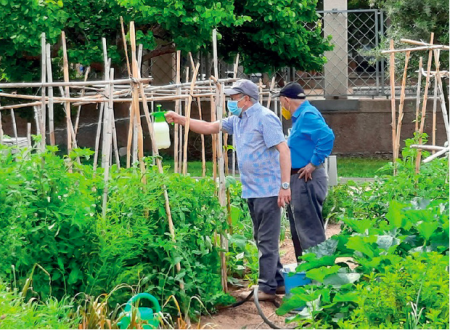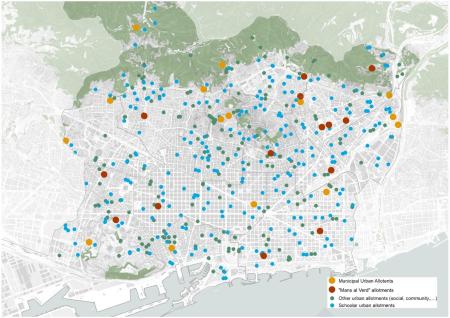
Area characterisation:
Located in Catalonia, on the north-eastern coast of Spain, with a population of 1.63 million inhabitants and area of 101 km2, Barcelona is one of the most compact and densest cities in Europe. With 34% of the city’s surface being green cover (around 3,463 ha), 77% of which is public, Barcelona is committed to becoming an increasingly greener city. In the last decade, several policies and strategic agendas have been implemented by the City Council to expand green infrastructure networks (e.g. the 2017 Programme for Enhancing the Urban Green Infrastructure), enhance the biodiversity of urban ecosystems (e.g. Barcelona's Green Infrastructure and Biodiversity Plan 2020; the Nature Plan 2021-2030), and boost sustainable urban agriculture practices (e.g. the Strategy for Urban Agriculture 2019-2030; Barcelona Healthy and Sustainable Food Strategy for 2030).
Currently, 91.2% of Barcelona’s residents have access to green space (i.e. green squares, pocket parks, parks, courtyards) within a 5-minute walk and 67.2% have access to a park bigger than 1ha (i.e. historic parks, regular parks) within a 5-minute walk (Barcelona Regional, 2022).
The city counts with more than 500 urban allotments, 329 of which are in schools, and 189 elsewhere. Among these 189, 29 were established by the municipal government as part of the Xarxa d’horts Urbans (or ‘Urban Allotments Network’) and the Mans al verd (or ‘Hands to green’) programme (Barcelona Regional, 2022). Other types of urban allotments were established by NGOs, social entities, or as informal community gardens. The rest can be categorised as municipal urban allotments belonging to specific city districts.
Objective:
In the context of the CONEXUS project, 47 of the 189 municipal allotments are being monitored by the Observatori d’Horts urbans (or ‘Urban Allotment Observatory’), a key legacy of the city’s Strategy for Urban Agriculture 2019-2030. Led by Barcelona Regional, a technical agency specialised in strategic urban planning and infrastructure, and in partnership with Barcelona City Council, the Urban Allotment Observatory analyses the ecosystem services and socio-environmental benefits of urban allotments, linking them to the city’s green infrastructure, and enhancing the evidence-base of urban agriculture’s integrated benefits for citizens and the environment.
Via the Observatory, the Barcelona Life-Lab aims to establish a database of environmental and social characteristics of urban allotments. Linked to this, the Life-Lab aims to:
- Gather information on agricultural production, cultivated biodiversity, food quality (pollutants accumulation, retention, and phytoremediation), users’ health, social relations, and other ecosystem services related to urban allotments;
- Create a space for community-building, fostering communication around and participation in urban agriculture activities, open to allotment users, public/private entities, civil society associations, and the general public;
- Position Barcelona as a reference city for urban agriculture policies.
By monitoring urban allotments’ multidimensional impacts, learnings and methodologies for replication in other areas, especially deprived neighbourhoods, will be extracted.
Images
Financing:
Horizon 2020 programme
Potential impacts/benefits:
- Naturalisation of urban spaces, enhancing the biodiversity (flora and fauna) of existing green infrastructures, including parks and urban allotments;
- Boosting the agricultural productivity of urban allotments and improving both biodiversity and quality of cultivated products;
- Promoting users’ learning and building local capacity on sustainable agriculture practices (i.e. agroecology, organic farming, etc.);
- Building an online platform to centralise the results of the Life-Lab, disseminate on the benefits of urban gardens, and to promote policies that support their upscaling.
- Ameliorating users’ health and quality of life, and the social value of green space.
Actions:
The Life-Lab consists of three interlinked pilots.
Pilot 1 ‘Naturalising places: monitoring naturalisation’ involves the identification and study of existing green infrastructure in the city with a view to planning its expansion and amelioration. This pilot identifies and analyses green infrastructure in the city, linking urban allotment functions to Barcelona’s green infrastructure network. Among other things, Pilot 1 looks at 355 urban parks in the city, using 52 indicators to monitor 29 socio-environmental services clustered according 8 categories (including ecological/regulating, leisure, sports, health, psychological/spiritual, social/relational, urban planning, tourism/economy).
Pilot 2 ‘Monitoring urban allotments: social and ecosystem services’ entails the analysis of existing urban allotments, focusing on main characteristics and socio-environmental services provided, including ecosystem services. The final output will be an interactive online platform showcasing urban allotments benefits based on monitored indicators, urban allotments’ user surveys, and GIS analysis.
Linked to Pilot 2, Pilot 3 ‘Monitoring pollutants in urban allotments’ focuses on analysis potential risks for users’ health as a result of pollution and contamination of cultivated products in urban allotments.
Organisations:
- Barcelona Regional
- Barcelona City Hall, Park department
Contacts:
Barcelona Life-Lab:
- Marc Montlleo, Barcelona Regional, marc.montlleo@bcnregional.com
- Arnau Lluch, Barcelona Regional, arnau.lluch@bcnregional.com
- Adrian Cabezas, Barcelona Regional, adrian.cabezas@bcnregional.com
SDGs/NUA data:
- Federica Risi, EUKN, federica.risi@eukn.eu
Publications and reports:
This case study is also available in Spanish
CONEXUS Deliverable 6.1 Report. Data on SDG/NUA impacts/potentials linked with investment propositions uploaded to Oppla.
Further information:
References
- CONEXUS Deliverable 3.1 Report with action plans for each Life-Lab (internal).
- CONEXUS Deliverable 2.2 Seven detailed EU and CELAC cases on NBS challenges and opportunities addressed: ‘Integration of NBS in local governance contexts and urbanisation trajectories in CONEXUS EU and CELAC cities. Evidence from Barcelona, Buenos, Aires, Bogotá, Lisbon, Santiago, São Paulo and Turin.’
- CONEXUS Deliverable 4.1 Assessment framework, indicators and participatory monitoring process.
- CONEXUS Deliverable 6.1 Report. Data on SDG/NUA impacts/potentials linked with investment propositions uploaded to Oppla.
- Barcelona Life-Lab CONEXUS Factsheet ‘Urban Agriculture Observatory: Social and Ecosystem Services’, July 2023.
- ‘Measuring urban green and assessing integrated benefits’. Presentation by Arnau Lluch, Barcelona Regional, for the EUKN Policy Lab ‘Enhancing Green Spaces in Cities’, 20th October 2022.
